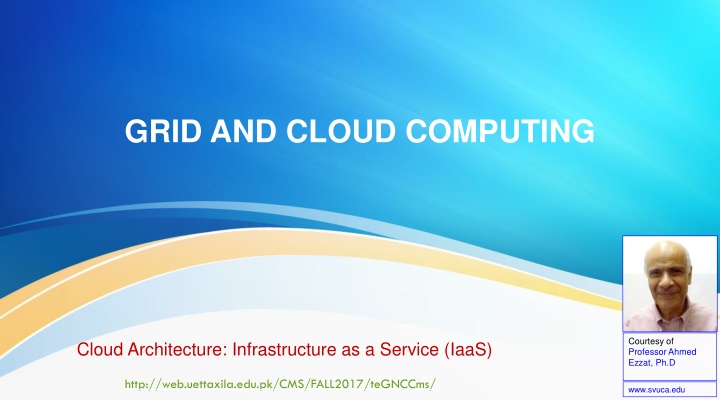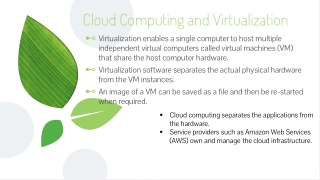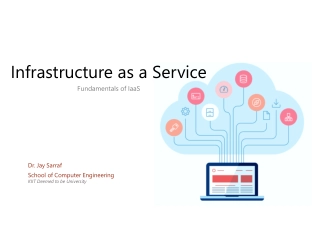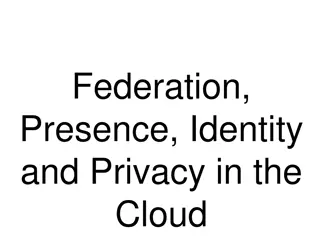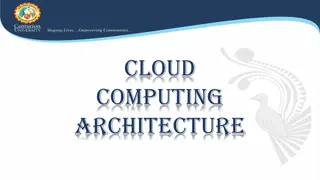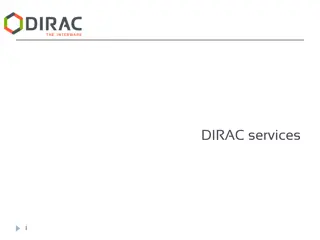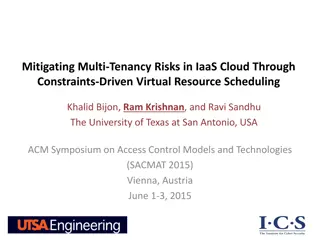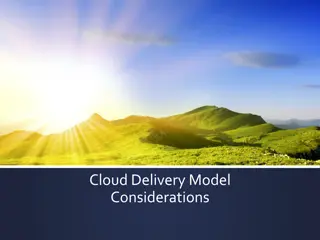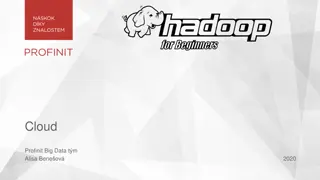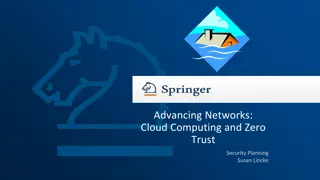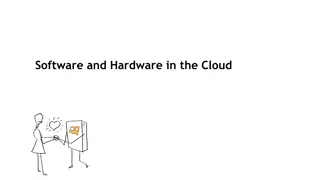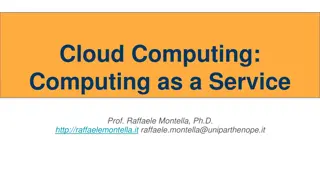Cloud Computing Infrastructure: IaaS Overview
Cloud computing infrastructure, specifically Infrastructure as a Service (IaaS), is explored in this content. Topics covered include the motivation behind IaaS, overview of IaaS platforms, benefits such as scalability and flexible billing options, and key players in the cloud computing landscape. Various images and diagrams illustrate concepts related to IaaS, cloud architecture, and migration strategies.
Download Presentation

Please find below an Image/Link to download the presentation.
The content on the website is provided AS IS for your information and personal use only. It may not be sold, licensed, or shared on other websites without obtaining consent from the author.If you encounter any issues during the download, it is possible that the publisher has removed the file from their server.
You are allowed to download the files provided on this website for personal or commercial use, subject to the condition that they are used lawfully. All files are the property of their respective owners.
The content on the website is provided AS IS for your information and personal use only. It may not be sold, licensed, or shared on other websites without obtaining consent from the author.
E N D
Presentation Transcript
GRID AND CLOUD COMPUTING Courtesy of Professor Ahmed Ezzat, Ph.D Cloud Architecture: Infrastructure as a Service (IaaS) http://web.uettaxila.edu.pk/CMS/FALL2017/teGNCCms/ www.svuca.edu
UNIT 9: INFRASTRUCTURE AS A SERVICE - Cloud Architecture Infrastructure-as-a-Service (IaaS) Motivation Overview The IaaS Stack Migration Strategy What to Watch for? VM for IaaS Environment Infrastructure Services Effect of Virtualization & Cloud Computing on Data Centers Summary and Conclusion 2
Cloud Architecture e.g., Web browser SaaS , e.g., Google Docs PaaS, e.g., Google AppEngine IaaS, e.g., Amazon EC2 4
Cloud Architecture PaaS IaaS Amazon EC2 Clients can rent virtualized hardware, can control the software stack on the rented machines Google AppEngine Provides a programmable platform that can scale easily Microsoft Azure Clients can choose languages, but can t change the operating system or runtime https://azure.microsoft.com/en-us/free/ 5
IaaS: Motivation - On-Premise Application Lifecycle 6
IaaS: Overview IaaS Platform should allow you to automatically provision servers, storage, and network elements with flexible billing options IaaS should provide building blocks that allow you to shape your infrastructure to fit your changing needs of your business and to respond quickly as needs change Benefits: No upfront cost Multi-tier auto provisioning within hours Scalability, services/resources are provided on demand Flexible/Secure direct connectivity SLA with 99.9% uptime 7
IaaS: Overview IaaS provides an environment for running user built virtualized systems in the cloud 8
IaaS: The Stack Many players; the cloud is just beginning In the future, expect to see all large vendors riding on the complete stack 9
IaaS: Migration Strategy: Staged or Direct Migration Virtualized Instance Hardware P2V Public Cloud V2V P2V P2V Virtualized Instance Hardware Virtualized Instance Hardware V2V Private Cloud 10
IaaS: What to Watch For? Check that your security policies can be satisfied by the Cloud provider Does the SLA meet availability requirements? You are now porting your OS and upper stack You will need to maintain it Remember the Cloud is in its infancy It s immature We all have lots to learn... 11
IaaS: Building VM for an IaaS Environment Runtime environment is shown on the RHS Once a VM is uploaded to an IaaS Environment, it can be configured to use the IaaS s raw storage VM is ready to run and the application within it Building application to run in an IaaS is similar to building it to run on premise Developers use familiar tools, programming languages, and any needed licensed products (DBMS, workflow, etc.) Once app development is completed, the application and any licensed software are installed on a VM; VM is thought of as a container that insulate the app from the runtime environment 12
IaaS: Inside VM Built for an IaaS Environment 13
IaaS: Infrastructure Services https://github.com/eucalyptus/eucalyptus IaaS can be viewed as three categories: Servers, Storage and Connectivity Cloud Providers would offer virtual Server instances on which the customer can install and run a custom image. Persistent storage is a separate service which the customer can purchase. Finally, several offerings for extending connectivity options Amazon is the de-facto standard for IaaS. Most IaaS offerings are either complements to Amazon Web Services (AWS) or competitive to them There is an open source equivalent to AWS and roughly compatible to its APIs, Eucalyptus (Elastic Utility Computing Architecture for Linking Your Programs To Useful Systems); shipped with Ubuntu since version 9.4 14
IaaS: Infrastructure Services https://alinush.github.io/eucalyptus-3.2/ Servers: Servers represent compute resources along with minimal storage and IO channels Server outsourcing model is divided into three allocation options: (1) Physical, (2) Dedicated Virtual, and (3) Shared Virtual Physical means dedicated hardware. Dedicated Virtual means dedicated hardware but with a hypervisor so the customer can run multiple OS. Shared Virtual are exposed to customers as pool of VMs Amazon is Shared Virtual, each is based on Amazon Machine Image (AMI). Customer can use pre-packaged AMIs from Amazon or build their own A challenge for Virtual servers is that they do not maintain local storage; any configuration information has to be stored externally 15
IaaS: Infrastructure Services https://www.rackspace.com/openstack Some offerings such as Rackspace Cloud offers local persistent storage as well as large pool of dedicated IP addresses on all instances Storage: Moving from storage Networks (SAN) to Storage-as-a-Service. It is characterized by a location-agnostic, virtualized data store with the illusion of infinite capacity while easy to use. Storage services are also useful for archiving, content delivery, disaster recovery, and web application development To cater to cloud, vendors like EMC with their Atmos product, have begun to deliver h/w and s/w that is specifically designed for geographically dispersed content depots with replication, versioning, de-duplication, and compression capabilities https://www.emc.com/storage/atmos/atmo s.htm 16
IaaS: Infrastructure Services On-demand storage services, relevant factors include persistence, replication, access speed and latency Due to synchronization requirements of Content Delivery Networks (CDN - Akamai), you may observe very different speeds for Read and Write data Amazon offers two persistent storage capabilities: (1) S3 (Simple Storage Service) and (2) EBS (Elastic Block Storage) Amazon AMI do not have persistent storage but locally mounted disks can be used for logs, interim data, etc. S3 is accessible through REST and SOAP APIs. It offers distributed, redundant buckets that are replicated using Amazon s CloudFront CDN across Europe, Asia, and US. S3 can accommodate data sizes from 1 Byte 5GB and provide permissions for access control based on AWS authentication 17
IaaS: Infrastructure Services S3 provides versioning so that customers can recover accidentally deleted or overwritten objects EBS is intended for high-performance virtual hard disk. It can be formatted as a file system and then mounted on any EC2 instance. The size can range from 1 GB 1 TB. Amazon provides a mechanism to store an EBS snapshot in S3 for long term durability Other storage services include: The Rackspace Cloud: similar to S3 with REST Access API GoGrid: no access API; mechanisms such as secure Copy (SCP), FTP, Samba and rsync LayeredTech: The Dynavol service supports mirroring and many access mechanisms including:HTTP, FTP, SFTP, SSH, SCP, rdiff, rdist, rsync, and smbfs 18
IaaS: Infrastructure Services Hadoop HDFS: partitions large files across several network hosts. It delivers blocks of data over the network using propitiatory protocol or HTTP for browser access. Data nodes communicate with each other to rebalance data and to maintain replication of data high (default is 3) Amazon also provides Cloud Database (Amazon Simple DB) for structured data. While data is tabular, it is not conformant and does not support JOIN, foreign keys, triggers, and stored procedures Simple DB does not use schema; instead it defines domains with items that consist of up to 256 attributes and values. Value can be from 1B to 1KB. Simple DB supports simple operators. Queries are confined to a single domain 19
IaaS: Infrastructure Services Simple DB supports simple operators. Queries are confined to a single domain Other interesting data services include: Google Big Table: extremely large scale DBMS in the PB range Dynamo: Amazon s version of Big Table Cassandra: Facebook distributed storage system Network: Amazon EC2 instance will receive single DHCP (Dynamic Host Configuration Protocol) address. Additional addresses, static or persistent domain addresses, can be requested separately 20
IaaS: Infrastructure Services Two other network-related functions are available: (1) provisioning for network segmentation and mechanism to bridge segments. (2) Load balancing. Amazon allow customers to define firewalls which restrict the inbound/outbound traffic to specific IP range and port numbers Other Cloud providers, such as AppNexus, provides each customer with a private VLAN, i.e., avoids being exposed to broadcast traffic Amazon Virtual Private Cloud (VPC) enhances and secures connectivity between cloud services. It allows an Enterprise to create a VPN between the Enterprise and Amazon AWS Once connectivity is established, the next task is ensuring that it performs! Two factors defining network performance: (1) latency. (2) Throughput or bandwidth available from the network 21
IaaS: Infrastructure Services http://hadoop.apache.org/ Many providers offer Load Balancing capability. One option is to use a DNS Round-Robin that involves adding multiple IP addresses to the same DNS Domain. Alternatively is to use either software or hardware load balancer Integration: After setting the network connectivity, next step is to configure the application to be able to exchange data. In theory, IaaS is not the right level to facilitate integration; it is rather an added value provided by many of the Cloud providers Amazon provides Simple Queue Service (SQS): it is unlimited number of queues and messages with message size is up to 8 KB. Apache Hadoop provides a framework for tightly coordinated interaction of applications (Job Tracker, Task Tracker) 22
IaaS: Infrastructure Services Management: IaaS components are managed through the vendor virtualization facilities. Depending on the hypervisor used, there are 3rd party and native components for Xen, Vmware, Hyper-V, KVM, etc. In addition, there may be an umbrella management framework such as BMC Patrol, CA Unicenter, IBM s Tivoli, etc. For Public Cloud, there are services that help manage established infrastructure providers: Elastra, RightScale, enStratus, etc. provide management services for Amazon EC2 as well as other IaaS offerings Payment and Billing: Monetization of utilities-based services relies on: (1) fine grained metering. (2) Simple and trustworthy payment system 23
IaaS: Infrastructure Services Many Cloud offerings are from international communication giants such as BT, NTT, etc. eCommerce companies are also visible in that space such as PayPal Still many Cloud providers developed their own instrumentation and billing system IaaS is frequently used as SaaS enabler, i.e., not providing only raw compute, storage, and network resources but also help to facilitate SaaS with payment and billing services Amazon Flexible Payments Service (FPS) is a service for developers, that leverages Amazon s sophisticated retail billing system. The customer can use the same identity, shipping details and payment information as they would for ordering directly with Amazon 24
IaaS: Effect of Virtualization and Cloud Computing on Data Centers Multi-tier hierarchical networking structure: Typically 3-4 layers including access layer switches, aggregation switches, and core switches. These core switches usually contain the vast majority of the intelligence in the network 25
IaaS: Effect of Virtualization and Cloud Computing on Data Centers Today s applications are more distributed, often multi- tiers, and are oriented toward service delivery The above applications architecture results in: Greater network traffic on the Ethernet network, including storage traffic such as iSCSI More storage traffic as applications use distributed file system Higher server-2-server traffic or VM-2-VM traffic 26
IaaS: Effect of Virtualization and Cloud Computing on Data Centers Limitations of hierarchical networking structure: The more network traffic, the more limitations with hierarchical networks including: Spanning Tree Protocol (STP) Limitations: STP detects and prevents loops in L2 networks by allowing only one active path from one switch to another Oversubscription: is an issue in the aggregation layer, e.g. Cisco Unified Computing System (UCS) may have oversubscription rates of anywhere from 4:1 to 32:1 in the aggregation layer! Port Extension Technology: IEEE is developing a port extender, which is physical switch with limited functionality Latency: can be more of a challenge than oversubscription and row bandwidth; due to the nature of traffic within an application 27
IaaS: Effect of Virtualization and Cloud Computing on Data Centers Changing Business Applications: 28
IaaS: Effect of Virtualization and Cloud Computing on Data Centers Server Virtualization (VM): Increase in VM density and with more powerful CPU & memory subsystems resulted in greater performance demand on the network subsystem at the server-network edge. Moving workloads dynamically requires VMs to stay within a common VLAN in the same layer-2 29
IaaS: Effect of Virtualization and Cloud Computing on Data Centers 30
IaaS: Effect of Virtualization and Cloud Computing on Data Centers Client Virtualization (Virtualized Desktop Infrastructure - VDI): a specialized type of VM is the client virtualization technology such as Virtual Desktop Infrastructure (VDI). VDI creates a client desktop as a VM. The VDI instance is more than simple VM, it includes real-time compilation of the end- user s data, personal settings, and application settings with a core OS instance and a shared generic profile. Applications and user personality are injected into the core desktop VM, and a brokering mechanism manages connecting the end-users to the VM 31
IaaS: Effect of Virtualization and Cloud Computing on Data Centers 32
Summary and Conclusion Cloud architecture consists of IaaS, PaaS, and SaaS IaaS is the foundation of Cloud Computing Virtualization is central technology for IaaS IaaS provides set of services: Servers, Storage, Network, Integration, Management, and Payment/Billing Virtualization and Cloud has a significant impact on the Data Centers 33
Assignment #8 - Write description/usage of the abbreviations used in Slides 18
Thank You Questions and Comments? http://web.uettaxila.edu.pk/CMS/FALL2017/teGNCCms/
